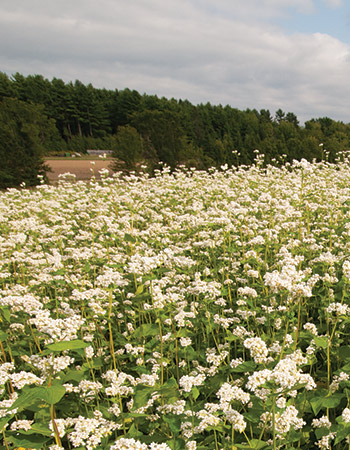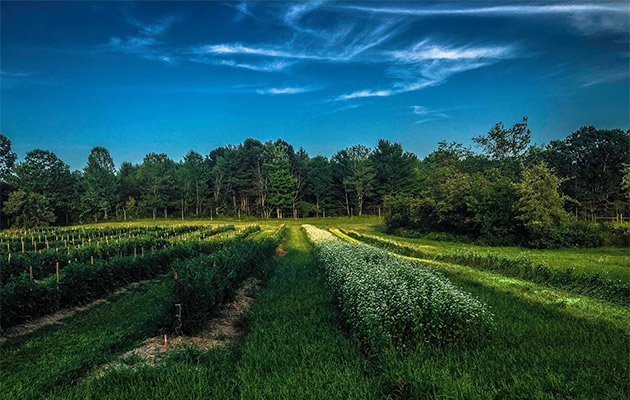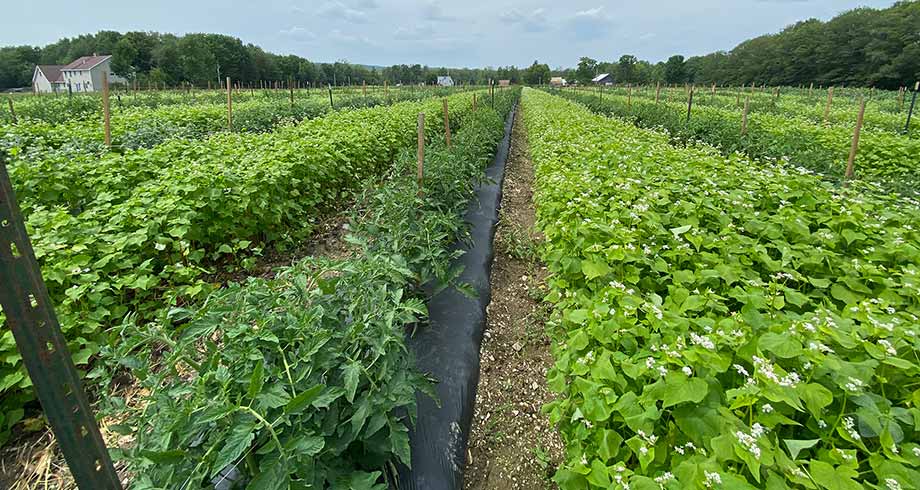by Lynn Byczyskni, Author & Founder of Growing for Market, with notes from Eero Ruuttila, former Farm Manager, Johnny's Selected Seeds
Quick, Easy, Summertime Solution

Buckwheat (Fagopyrum esculentum) is one of the easiest and quickest, summertime cover crop options, used primarily to suppress weeds and improve soil tilth, but simultaneously to help break up disease cycles and provide habitat for beneficial organisms. It is a warm-weather species that can be slotted in between spring and fall vegetables. Notes Eero Ruuttila, Farm Manager for Johnny's, now retired, "Buckwheat is a great set-up crop for prepping soil prior to planting late-July or early-August, fall carrots." It can also be useful when preparing new ground: when planted on newly prepared sod ground, buckwheat will help rot down the sod, for vegetable, flower, or berry production in fall or the following year.
Buckwheat forms attractive stands of plants, 2' to 4' in height, with triangular leaves and flowers of white, pink, or red. When grown as a cover crop, buckwheat can be planted as soon the soil is warm enough for seed germination, at least 55°F (12.8°C). It will germinate within days and begin to flower in about 4 weeks, proving an excellent source of nectar for honeybees and native pollinators as well as serving as a good thrip trap crop.
Seed ("groats") matures 2 to 3 weeks after flowering and, if left in the field, provides a food source for ground-dwelling birds such as quail and pheasant. Buckwheat will be killed by light frost. It does not provide nitrogen (N); nor does it increase soil organic matter significantly, but it does accumulate some phosphorus (P), and it will improve the soil condition within the top few inches, to the benefit of subsequently direct-seeded or transplanted vegetable, flower, or fruit crops.
Byczynski and her family have been growing vegetables and cut flowers since 1988, selling through CSAs, at farmers' markets, to chefs, grocery stores, and florists. They currently grow cut flowers and hoophouse tomatoes on about 2 acres of their 20-acre farm near Lawrence, Kansas.
She is also the author/editor of two of our favorite books about market farming, The Flower Farmer and The Hoophouse Handbook.
Buckwheat Cover Crop Handbook • Cornell Univ
Buckwheat Makes a Good Summer Cover Crop for Gardens • Oregon State Univ Extension Service
Cover Crop Database: Summary of Buckwheat • Univ California Sustainable Agriculture Research & Education Program
Johnny's Farm Seed & Cover Crop Comparison Chart • PDF
View All Our Farm Seed & Cover Crops Product List
Tips for Getting Your Buckwheat Crop Up Before the Weeds
The key to using buckwheat for weed control is to provide the optimum conditions for getting it up and growing ahead of weeds. Here are some tips for achieving a strong stand and managing it for improved vegetable production in the future.

- Before planting buckwheat, till in any weeds or plants from a previous crop. Wait 1 week for the debris to decompose sufficiently, in order for the buckwheat seed to germinate. Break up big clumps of soil, and create the finest seedbed possible.
- Let the soil warm up, and if conditions have been wet, allow it to dry out. Buckwheat seed rots easily in cold, wet soil. If the soil is extremely dry, however, irrigate to a depth of 1" before planting. Notes Eero Ruuttila, "It's important for the soil to be warm, so late May or early June are good seed dates here in the Northeast. Adequate moisture is important for good germination, and light covering by shallow harrowing."
- For best germination, buckwheat seed should be barely covered with soil. Do not plant too deeply, but do not leave the seed exposed on the soil surface, either. Ruuttila suggests "utilizing a cultipacker… to seal in moisture and provide good seed-to-soil contact."
- Buckwheat seed can be hand-broadcast at a rate of 60 pounds per acre, provided that care is taken to spread it evenly. Or, it can be drilled to a depth of less than 1 inch at a rate of 50 pounds per acre. If there is heavy weed pressure, however, or your preference is for thick buckwheat stands with minimal to no gaps, you may want to increase the rate. Ruuttila notes he "usually seeded at a heavier rate… 80 pounds per acre or more."
- As the seed germinates, check for gaps in the stand, and reseed any bare spots wider than 1' in diameter. If weeds are allowed to grow in these empty areas, they will produce seeds that continue the weed cycle, and the benefits of the buckwheat will be reduced.
- The plants should start to flower about 4 to 6 weeks after seeding. If the land is needed for a fall crop, mow the buckwheat before the seeds mature. If the land will not be needed until the following year, the buckwheat can be left to reseed, and a second crop can be grown in the same season. Buckwheat will not overwinter, however, so it should be mowed and replaced with a winter cover crop in late summer or fall.
Learn More
- Buckwheat for Cover Cropping in Organic Farming• USDA NIFA eXtension
- Buckwheat Cover Crop Handbook • Cornell University
- Buckwheat Makes a Good Summer Cover Crop for Gardens • OR State University Extension Service
- Cover Crop Database: Summary of Buckwheat • University of CA Sustainable Agriculture Research & Education Program




